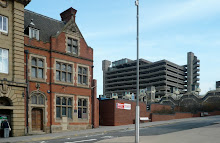
07.03.08 - 12.04.08
BISCHOFF/WEISS is pleased to present Monologue/Dialogue II, a group show of works by British and Thai artists.
Monologue/Dialogue Part I was exhibited at the Bangkok University Gallery in 2006 in partnership with the British Council, Bangkok. The show featured works by Thai artists as well as a group of British artists who were invited to take part in a residency in Thailand. Following on from the success of this exhibition and the artistic dialogue and connections it created we are pleased to present Part II. The show will include works created specifically for this occasion ranging from painting and sculpture to mixed media and installation.
The exhibition showcases three artists from Thailand: Sansern Milindasuta, Nipan Oranniwesna, who has been invited as an artist-in-residence in the UK, and Panya Vijinthanasarn. Exhibiting alongside will be British artists Eric Bainbridge, Rana Begum, Nathaniel Rackowe and Andrew Stahl.
Recent works by Eric Bainbridge take their cue from constructivist and minimalist architectural ideals employing a simplicity of object selection, construction and display. By subtly manipulating humour within sculptural configurations, Bainbridge examines aspects of the mundane, mobilising historical art quotation and thereby sustaining a continuous relation to the ‘present’.
A fascination with repetition and geometry, which is the vocabulary of Islamic art and architecture, is the starting point for Rana Begum’s installations. Her work fuses elements of contemporary Western ideals, and the symbolic, spiritual dimensions found in Islam and the arts.
Sansern Milindasuta uses a wide variety of media encompassing sculpture, painting, sound, drawing and installation. The dialogue that he embraces is international and complex and allows for politics, humour and experimentation to coexist.
Nipan Oranniwesna’s work uses a minimalist vocabulary and symbolic materials including baby powder, rice, Buddhist clothing and gourd to provide the viewer with a rendition of the artist’s birthplace. His works are created mostly from personal memories.
Using light, kinetic elements, and common industrial materials, Nathaniel Rackowe makes works that animate architectural spaces and transform viewers into active participants. His pieces, often built on-site, explore the boundaries of physical spaces, moving through them or casting light about their perimeters like search beacons.
The paintings of Andrew Stahl approach cultural differences and connections using pictorial language, imagination, figuration and decorative pattern. His images become vehicles to carry painterly experimentation. Much of his work reflects on travels to Japan and Thailand and addresses the conflation of time, space and different cultures.
Panya Vijinthanasarn’s art is grounded in Buddhism with references to Buddhist cosmology, the struggle to overcome the forces of desire and the importance of harmony with nature. His use of the sacred Buddha image, especially the face of Buddha, has been a major part of his artistic oeuvre in recent years.





